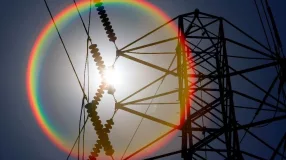On June 26, 2019, INGAA and the INGAA Foundation hosted a Natural Gas Pipeline Technology Showcase on Capitol Hill, educating lawmakers, federal agencies and their staff members on the different types of inspection tools used to inspect interstate natural gas transmission pipelines. Four service providers displayed their in-line inspection tools, also known as “smart pigs,” demonstrating their features and sharing examples of the data they collect. We spoke to a representative from each company to learn more about the technologies they deploy to keep our natural gas infrastructure safe.
– – – – –
Company name: The ROSEN Group
HQ location: Stans, Switzerland
Q&A with Bryce Brown, Vice President, Industry, Regulatory & Public Affairs
ROSEN is a worldwide leading technology and service company that operates in more than 120 countries. “Empowered by technology” is our promise at ROSEN to enhance our customers’ asset operations and to make them safe, cost-effective and more efficient. Our expertise is in delivering solutions leveraging state-of-the-art inline inspection (ILI) technologies augmented by subject matter experts in materials, engineering, risk, data management and science to make decisions related to safety, performance, compliance and asset life extension more valuable.
Q: What is the name of the tool you presented at the event and how does it work?
A: The presented ILI tool was equipped with Electro-Magnetic Acoustic Transducer (EMAT) technology and is an autonomous vehicle that traverses a pipeline during its normal operation for the inspection of crack and crack-like pipe wall anomalies/defects. The EMAT sensor technology utilized is unique in terms of its capability to generate ultrasound in a gas pipeline, and thus enable this detection, identification and sizing of crack and crack-like anomalies/defects.
Q: What makes this tool effective? Is it unique in the technology it uses?
A: The EMAT ILI tool is equipped with an industry-unique “high-resolution” sensor and configuration, paired with a robust, high-performance data acquisition system onboard that can take measurements every 0.2” along the pipeline. This high-resolution data collection is then processed and rendered with proprietary software and analyzed by trained and qualified personnel to realize the characterization (identification and quantification/sizing) of the associated pipe wall anomalies/defects. This inspection service delivers details of the pipeline with regard to the position and dimensions (depth, length and interaction) of crack and crack-like anomalies/defects along the entire inspection length. Our EMAT ILI System is unique as it leverages more than 10 years of industry-based technology improvements and enhances the evaluation process by integrating integrity engineering subject matter experts to deliver the highest level of confidence in ILI results and crack assessment.
Q: What do you think is most surprising about this technology – or safety efforts in general – to those outside the natural gas pipeline industry?
A: The conventional integrity assessment for cracks has been pressure testing, which takes the pipeline section out of service and unfortunately offers minimal information about associated anomalies/defects in the pipeline. This EMAT ILI now enables pipeline operators to understand details about crack and crack-like anomalies/defects in their assets. Having this data allows for sound integrity decisions to be made related to safety and performance. Our greater than 30 years of ILI and technology development experience has resulted in a sound and valuable tool for the challenging threat of crack and crack-like anomalies/defects. The ability to collect data on these anomalies/defects has enabled data science techniques to establish the foundation for future innovated data rendering techniques such as machine learning. As pipelines are typically not visible in our daily lives, the efforts taken to monitor their safety and their performance require a duty of care which leverages data, sound engineering and safety-related culture. Understanding the details about our pipelines is a critical and significant effort.
Q: In addition to the tools and technologies themselves, what other safety and integrity measures does ROSEN take to protect the industry’s critical infrastructure?
A: ROSEN is a technology developer, service provider and integrity partner to the pipeline industry. Our brand is recognized as a leader in producing the data required for making integrity-based decisions. Our product & service portfolio delivers tools, technologies, services and solutions to comprehensively bring together all efforts related in executing integrity management programs, including but not limited to: Insitu-NDT/-NDE (non-destructive testing / examination), pipeline cleaning, pipeline inspection via ILI, advanced integrity engineering and data management for Geographic Information Systems and compliance. Supporting operators in all of these elements reduces inefficiencies in transfer of knowledge and empowers well-informed decisions. ROSEN also understands we are a valuable industry stakeholder, and therefore we work to support innovation, industry collaboration and presence in research, partnership and service.
Q: Is there anything you’d like to add?
A: Events like this, the INGAA and INGAA Foundation-sponsored Natural Gas Pipeline Technology Showcase, are a great opportunity to provide the public with insight into some of the more important tools and technologies used to protect and secure our oil and gas infrastructure. Transparency in technology, service and procedures is the basis for any productive and educated discussion. As a technology developer and service provider, we know that partnership and collaboration are the keys to safety, progress and success.






